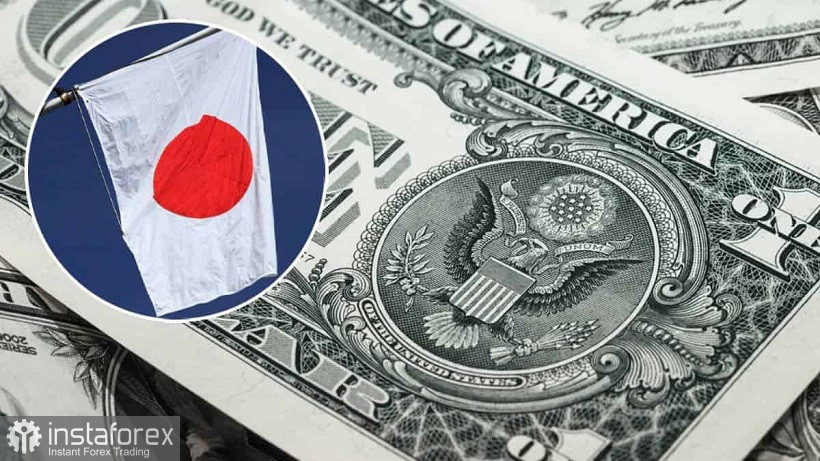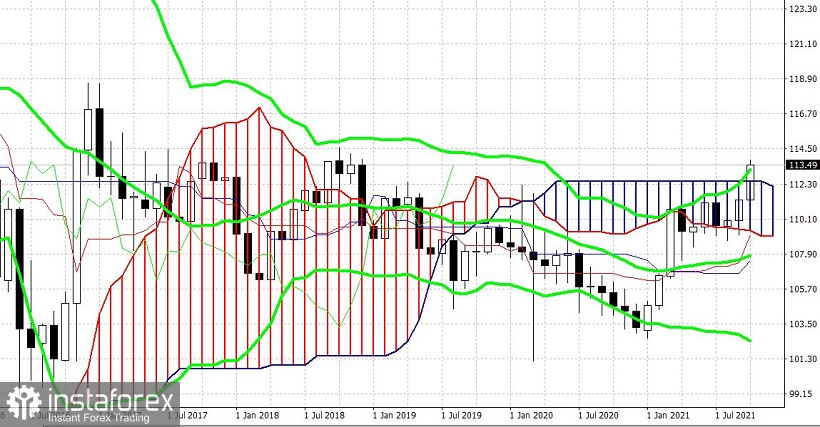The Japanese yen continues to lose its positions both in pair with the US dollar and with the main crosses. Yesterday, the USD/JPY pair updated another price high, reaching the level of 113.80. This is a long-term record – the last time the price was at such heights was in December 2018, when it updated the monthly high at 114.24. To date, traders are also approaching the 114th mark, and we believe that it is only a matter of time, judging by the impulse and multi-week growth.
The USD/JPY pair has been within a strong upward trend for the fifth week in a row. And although the upward dynamic is accompanied by quite deep corrective pullbacks, the price has been consistently rising since the beginning of September. At the same time, buyers have repeatedly tried to break through the resistance level of 110.00 in the summer. If we look at the weekly chart of this instrument, it shows that the pair literally crossed this target every week, but it came back each time, falling under the pressure of sellers. However, in early autumn, the pair's bulls made a decisive march, taking advantage of the strengthening of the US currency and the simultaneous weakening of the yen. Recently, the upward dynamics have only been gaining momentum – the strongest intraday growth of the pair was recorded yesterday since November 2020.

In general, experts note the atypical nature of the current situation. As a rule, the Japanese currency moves on the wave of the US dollar, which now shows quite passive behavior in the main major currency pairs. And although the US dollar index is in good form, being within the 94th figure, its dynamics is not comparable to the dynamics of the USD/JPY pair. Therefore, the situation is not led by the greenback, but by the yen. In fact, the main cross-pairs with the participation of the Japanese currency confirmed this. It is enough to look at such crosses as GBP/JPY, EUR/JPY, or AUD/JPY to make sure that the yen is under strong pressure all over the market.
There is no consensus among experts as to why the yen is falling. To be more precise, analysts name several reasons for this behavior, focusing their attention on one of them. The phrase "energy crisis" sounds most often.
Japan, which is the world's largest importer of liquefied natural gas, is in a vulnerable position in the face of the global energy crisis. It is reported that Japanese electricity producers decided to raise electricity prices for the first time in 8 years. At the same time, the sudden onset of cold weather may force energy producers to enter the spot market for urgent gas purchases at record prices. Commenting on the current situation, Bloomberg notes that "the world will surely find out how much the world economy depends on natural gas" in the coming winter. So, judging by the behavior of the yen, we believe that the markets are beginning to worry about the impact of expensive energy on the Japanese economy.
In addition, the pre-election period in Japan contributes to the determination of the USD/JPY upward trend. The new Prime Minister of the country and the leader of the ruling Liberal Democratic Party Fumio Kishida dissolved the House of Representatives of the Japanese parliament at the beginning of the month and scheduled re-elections for October 31. During one of his speeches (which was obviously agitational), he stated that the government "needs to think about revising the tax on financial income." The markets reacted to his words with increased volatility. Thus, the head of the Cabinet of Ministers of Japan hastened to clarify his words, refuting what had been said earlier. He noted that the information disseminated in the media is "erroneous" since the tax policy will not be changed immediately. At the same time, the prime minister added that the government needs to "do many more things" before considering the issue of capital gains tax. After these words, the yen was under additional pressure.
The divergence of the rates of the Federal Reserve and the Bank of Japan complements the overall fundamental picture for the USD/JPY pair. The Japanese regulator clearly outlined its position at its last meeting. He said that he would continue to implement a policy of large-scale incentives for at least the next two years, that is, until 2023. There is no question of raising the interest rate at all, while many Fed representatives are still voicing a "hawkish" position, despite the contradictory September Nonfarm data.
In particular, the vice-president of the US regulator Richard Clarida said yesterday that the current economic conditions allow us to start curtailing QE, thereby confirming the November benchmarks. He also noted that "bullish risks" for inflation prevail, and the growth of the American economy this year will be the highest in the last 38 years. A similar position was voiced by his colleague, the CEO of the Federal Reserve Bank of Atlanta, Raphael Bostic. In particular, he stated that the temporary slowdown in employment growth should not affect the timing of the curtailment of the incentive program. At the same time, he confirmed that the start of folding is scheduled for November.

Therefore, the prevailing fundamental outlook for the pair suggests that the upward trend is not yet over. The same thing is said by the technical analysis. On all the higher timeframes (including the monthly chart), the price is still on the upper line of the Bollinger Bands indicator and above all the lines of the Ichimoku indicator, which shows a bullish "Line Parade" signal on the D1 and W1 chart. The resistance level (the upward target) is the level of 114.56 – this is a three-year price high, which was reached in October 2018.
 English
English 
 Русский
Русский Bahasa Indonesia
Bahasa Indonesia Bahasa Malay
Bahasa Malay ไทย
ไทย Español
Español Deutsch
Deutsch Български
Български Français
Français Tiếng Việt
Tiếng Việt 中文
中文 বাংলা
বাংলা हिन्दी
हिन्दी Čeština
Čeština Українська
Українська Română
Română

